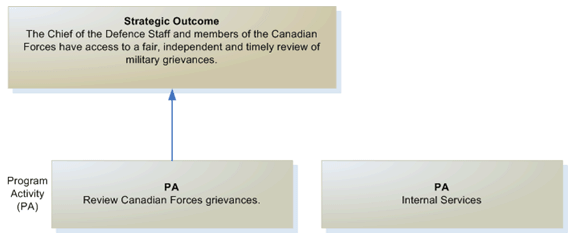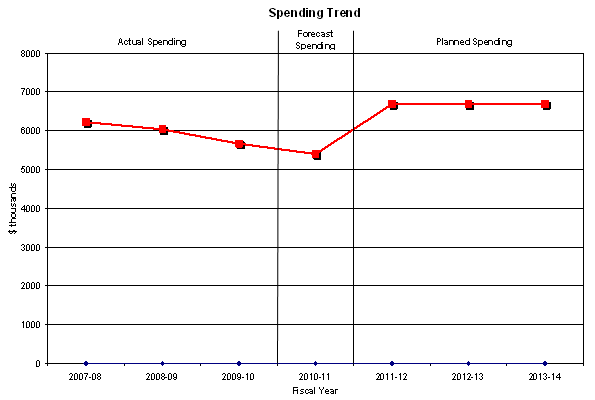Common menu bar links
Breadcrumb Trail
ARCHIVED - Canadian Forces Grievance Board - Report
 This page has been archived.
This page has been archived.
Archived Content
Information identified as archived on the Web is for reference, research or recordkeeping purposes. It has not been altered or updated after the date of archiving. Web pages that are archived on the Web are not subject to the Government of Canada Web Standards. As per the Communications Policy of the Government of Canada, you can request alternate formats on the "Contact Us" page.
Chairperson's Message

As the Chairperson of the Canadian Forces Grievance Board (CFGB), I am pleased to submit the CFGB's Report on Plans and Priorities for the period 2011-12 and 2012-13.
As we begin a new decade, we find ourselves facing new challenges that we will meet with the same enthusiasm that has served us so well and enabled us to move forward successfully in the first ten years of the Board's existence.
In 2011-12, we will be testing a new model for the referral of cases to the Board, known as the "principled approach". Under this model, the Board will review, at the final authority level, all grievances where the Canadian Forces (CF) have been unable to find a resolution acceptable to the grievor. During this trial period, the Chief of the Defence Staff and members of the CF will benefit from an independent review by the Board of all cases, regardless of the subject matter, before a final decision is rendered.
We have worked hard to prepare for this trial period, which is expected to result in a significant increase in the number of cases referred to the Board. This is a challenge that we are determined to meet, because we are deeply convinced of the advantages offered by this new model, both for the grievance system, which will be more robust and transparent as a result, and for the members, who will have the opportunity to have an external review of their cases regardless of the nature of the grievance.
At the same time, the Board will continue to share with the senior leadership and members of the CF important information on issues raised by the military grievances that we review. By publishing case summaries, recommendations on systemic issues, articles and bulletins, and through our regular contacts with the key stakeholders in the grievance process and with our partners, we share with decision-makers our observations on issues relating to the administration of the CF. The Board and I believe that these observations are extremely useful for preventing problems, as well as for aiding in the review and resolution of similar grievances.
With respect to our internal services, the Board will continue consolidating its administrative processes with a view to maintaining the standards of excellence it has set for itself. As we strengthen our work tools and systems, we will also focus on promoting and strengthening the safety and security of our staff and our workplace through a variety of initiatives, including, in the coming months, the finalization of our departmental security plan.
Our objective remains to fulfil our mandate and realize our vision of serving as a centre of expertise and a model administrative tribunal. All members of the CFGB team will continue to work together for the period covered by this report and beyond to ensure that we meet this objective.
Bruno Hamel
Chairperson
Section I – Overview
Raison d'être and Responsibilities
Raison d'être
The raison d'être of the Canadian Forces Grievance Board (CFGB or the Board) is to provide an independent and external review of military grievances. Section 29 of the National Defence Act (NDA) provides a statutory right for an officer or a non-commissioned member who has been aggrieved, to grieve a decision, an act or an omission in the administration of the affairs of the Canadian Forces (CF). The importance of this broad right cannot be overstated since it is, with certain narrow exceptions, the only formal complaint process available to CF members.
Responsabilities
The Board is an independent administrative tribunal reporting to Parliament through the Minister of National Defence.
The Board reviews military grievances referred to it and provides findings and recommendations (F&Rs) to the Chief of the Defence Staff (CDS) and the officer or non-commissioned member who submitted the grievance.
The Board also has the obligation to deal with all matters before it as informally and expeditiously as the circumstances and the considerations of fairness permit.
Strategic Outcome and Program Activity Architecture (PAA)
In order to effectively deliver on its mandate, the Board aims to become the centre of expertise in military grievances and a model administrative tribunal, through its fair and efficient processes, professionalism and good governance.
Strategic Outcome
Figure 1

Program Activity Architecture (PAA)
Figure 2

PAA Crosswalk
The 2011-12 Report on Plans and Priorities (RPP) details the Board's plans, priorities and expected results against the Board's new Strategic Outcome (SO) and Performance Measurement Framework. The new SO more accurately reflects the Board's mandate and vision and was approved as part of the Treasury Board Secretariat amendments process for 2011-12 and future year Estimates. As well, the allocation of spending and FTEs between the two program activities has been adjusted to ensure that the Board has the best possible information available regarding the costs of operations.
It is important to note that the 2011-12 Departmental Performance Report will be the first report to assess performance based on the revised and improved indicators and targets.
Planning Summary
| Financial Resources | 2011-12 | 2012-13 | 2013-14 |
|---|---|---|---|
| ($ thousands) | 6,683 | 6,683 | 6,683 |
| Human Resources | 2011-12 | 2012-13 | 2013-14 |
|---|---|---|---|
| Full-Time Equivalents (FTEs) | 46 | 46 | 46 |
*Includes Board Members appointed by Governor in Council.
Planning Summary Table
| Strategic Outcome: The Chief of the Defence Staff and members of the Canadian Forces have access to a fair, independent and timely review of military grievances. | |
|---|---|
| Performance Indicators | Targets |
| Percentage of clients who are satisfied with the Board's ability to improve the administration of the affairs of the Canadian Forces (CF) through the quality of its Findings and Recommendations (F&Rs) and the information tools it provides. | Data Source: Survey & interview of CF members, decision makers & administrators. At least 75% of respondents agree and strongly agree. |
| Trend in the % of surveyed grievors who are satisfied with the fairness, equity and transparency of the process. | Data Source: Grievor Survey. 70% of grievors agree and strongly agree. |
| % of Systemic recommendations accepted by the Chief of the Defence Staff (CDS). | Data Source: CDS Decisions where he agreed a systemic recommendation merited further action. 75% accepted. |
| % of CFGB's grievance process timeline standards met. | Data Source: CFGB statistics and monitoring information. Established standards are being met 75% of the time. |
| Program Activity |
Forecast Spending 2010-11 |
Planned Spending ($ thousands) |
Alignment to Government of Canada Outcomes |
||
|---|---|---|---|---|---|
| 2011-12 | 2012-13 | 2013-14 | |||
| Review of Canadian Forces grievances |
3,727 | 4,415 | 4,415 | 4,415 | and efficient government operations |
| Total Planned Spending | 3,727 | 4,415 | 4,415 | 4,415 | |
| Program Activity |
Forecast Spending 2010-11 |
Planned Spending ($ thousands) |
|||
|---|---|---|---|---|---|
| 2011-12 | 2012-13 | 2013-14 | |||
| Internal Services | 1,670 | 2,268 | 2,268 | 2,268 | |
| Total Planned Spending | 1,670 | 2,268 | 2,268 | 2,268 | |
Contribution of Priorities to Strategic Outcomes
| Operational Priorities | Type | Links to Strategic Outcome | Description |
|---|---|---|---|
| 1. Operational Performance – Ensure optimum productivity and excellence | Ongoing | The Chief of the Defence Staff and members of the Canadian Forces have access to a fair, independent and timely review of military grievances. | Why is this a priority? Ensure the high quality and timeliness of the Board's F&Rs and ongoing contribution to the fairness and efficiency of the grievance system for CF members. |
Plans for meeting the priority.
|
|||
| 2. Communicate the results of our review of grievances | Ongoing | The Chief of the Defence Staff and members of the Canadian Forces have access to a fair, independent and timely review of military grievances. | Why is this a priority? Ensure that stakeholders have a better understanding of the Board's role within the CF grievance system. Share the Board's perspective on issues that came to our attention while reviewing grievances. |
Plans for meeting the priority.
|
|||
| 3. Operational Performance – Maintain the overall effective management and leadership of the CFGB. | Ongoing | The Chief of the Defence Staff and members of the Canadian Forces have access to a fair, independent and timely review of military grievances. | Why is this a priority? Meet government-wide management and accountability priorities through management excellence and sound internal governance. |
Plans for meeting the priority.
|
Risk Analysis
External Context
In 2009, the CFGB, in coordination with the CF, began evaluating a new model for the referral of grievances, which the Board believes will add to the fairness and transparency of the military grievance process. Currently the Queen's Regulations and Orders for the Canadian Forces (QR&Os) stipulate that only certain categories of grievances are referred to the Board for review. Therefore, not every grievor whose grievance has reached the Final Authority (FA) level benefits from the Board's external review of his or her complaint.
Under this new 'principled approach' to grievance referrals, the Board would review all grievances at the final authority level where the CF is unable to resolve the matter to the satisfaction of the grievor. In those cases, the CDS and the CF member would benefit from the Board's independent review before a final decision is rendered. In October 2010, the Armed Forces Council approved a six-month trial of this approach which commenced in January 2011. During the trial period, the CFGB will continue working on files normally referred under the QR&Os as well as any other category of unresolved grievance, which will result in an increase in the number of cases referred to the Board. If the trial period is successful and the Principled Approach adopted by the CF, amendments to the NDA and QR&Os may be required to fully implement this initiative.
Key Risks
Several factors influence the Board's operating environment. There are three interrelated key risks that can affect the Board's ability to deliver on its mandate.
The first area of risk is that the Board has no control over the number of grievances referred to it in any given year. Significant, unpredicted fluctuations in the volume of cases referred would have an impact on our ability to deliver high-quality F&Rs to the CF in a timely manner. Similarly, significant fluctuations would have an impact on the financial and human resources planned by the Board. To mitigate this risk the Board will focus on developing and enhancing processes and tools to support quality assurance. As well it will continue to monitor workload planning assumptions on an ongoing basis and work in consultation with stakeholders within the CF to base these assumptions on the most up-to-date information possible.
The second risk area pertains to the Board's capacity to recruit and retain a skilled workforce. The Board's effectiveness is due in large part to its knowledgeable and stable workforce. However, like in other micro agencies, it is difficult to retain employees when, for the most part, the size of the organization limits the number of opportunities for advancement. In response, the Board will continue to maintain effective integrated human resource planning, anticipating potential staff turnover and developing staffing strategies to help ensure that knowledge is retained and vacancies are appropriately filled, as quickly as possible.
The third risk concerns issues relating to the integrity and completeness of information facing the Board's corporate functions. As other small organizations, the Board is faced with small pools where corporate knowledge resides and is vulnerable to departures in key positions which may result in inefficiency and ineffective use of time and resources. To mitigate this risk the Board is focussing on enhancing tools and systems to support effective knowledge management and knowledge transfer.
Expenditure Profile
For 2011-12 fiscal year, the Board plans to spend $ 6.683 million to meet the expected results of its program activities and contribute to its strategic outcome. Over the past few years, the Board has generally been consistent in its rate of spending. In 2010-11 and 2011-12, the Board intends to manage the anticipated increase in workload resulting from the trial of the new 'principled approach' within existing allocations.
Figure 3

Estimates by Vote
For information on our organizational vote and statutory expenditures, please see the 2011-12 Main Estimates publication. An electronic version of the Main Estimates is available at:
http://www.tbssct.
gc.ca/est-pre/20112012/me-bpd/info/info-eng.asp.
